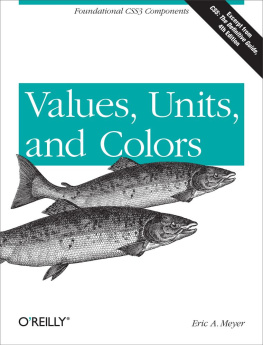Eric A. Meye - Selectors, Specificity, and the Cascade
Here you can read online Eric A. Meye - Selectors, Specificity, and the Cascade full text of the book (entire story) in english for free. Download pdf and epub, get meaning, cover and reviews about this ebook. year: 2012, publisher: OReilly Media, genre: Computer. Description of the work, (preface) as well as reviews are available. Best literature library LitArk.com created for fans of good reading and offers a wide selection of genres:
Romance novel
Science fiction
Adventure
Detective
Science
History
Home and family
Prose
Art
Politics
Computer
Non-fiction
Religion
Business
Children
Humor
Choose a favorite category and find really read worthwhile books. Enjoy immersion in the world of imagination, feel the emotions of the characters or learn something new for yourself, make an fascinating discovery.
- Book:Selectors, Specificity, and the Cascade
- Author:
- Publisher:OReilly Media
- Genre:
- Year:2012
- Rating:3 / 5
- Favourites:Add to favourites
- Your mark:
Selectors, Specificity, and the Cascade: summary, description and annotation
We offer to read an annotation, description, summary or preface (depends on what the author of the book "Selectors, Specificity, and the Cascade" wrote himself). If you haven't found the necessary information about the book — write in the comments, we will try to find it.
Exactly how does the cascade in Cascading Style Sheets work? This concise guide demonstrates the power and simplicity of CSS selectors for applying style rules to different web page elements. Youll learn how your pages presentation depends on a multitude of style rules and the complex ways they functionand sometimes collidewithin the documents structure.
This guide is a chapter from the upcoming fourth edition of CSS: The Definitive Guide. When you purchase either the print or the ebook edition of Selectors, Specificity, and the Cascade, youll receive a significant discount on the entire Definitive Guide when its released. Why wait when you can learn how to use selectors and other key CSS 3 features right away?
- Learn how to create CSS rules that apply to a large number of similar elements
- Group rules to make style sheets smaller and download times faster
- Understand how elements inherit styles from their parents
- Discover how reader and browser preferences affect your page presentation
- Examine specificitythe method browsers use to choose between two conflicting style rules
- Get a handle on how specificity and inheritance combine to form the cascade
- Get details on all of the CSS3 selectors
Eric A. Meye: author's other books
Who wrote Selectors, Specificity, and the Cascade? Find out the surname, the name of the author of the book and a list of all author's works by series.





![Eric A. Meyer [Eric A. Meyer] - Padding, Borders, Outlines, and Margins in CSS: CSS Box Model Details](/uploads/posts/book/119142/thumbs/eric-a-meyer-eric-a-meyer-padding-borders.jpg)







